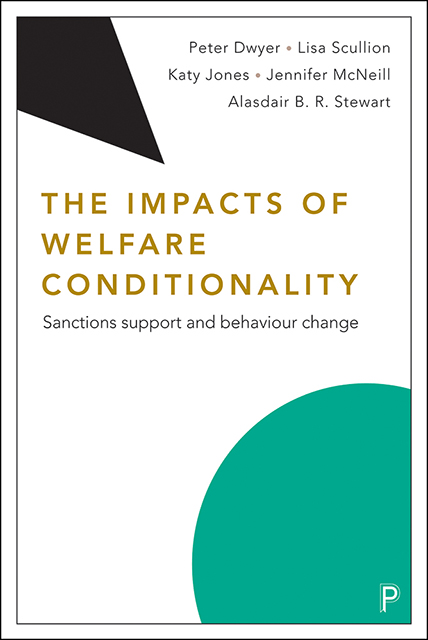Book contents
- Frontmatter
- Contents
- List of figures and tables
- List of abbreviations
- About the authors
- Acknowledgements
- One Introduction
- Two Conditionality in the UK welfare state
- Three Welfare conditionality and behaviour change
- Four From welfare to work? The effectiveness of welfare conditionality in moving people into paid employment
- Five Welfare conditionality and problematic or antisocial behaviour
- Six Unintended outcomes? The wider impacts of compulsion and benefit sanctions in social security
- Seven Ethical debates
- Eight Conclusions
- Methods appendix
- References
- Index
Five - Welfare conditionality and problematic or antisocial behaviour
Published online by Cambridge University Press: 17 June 2023
- Frontmatter
- Contents
- List of figures and tables
- List of abbreviations
- About the authors
- Acknowledgements
- One Introduction
- Two Conditionality in the UK welfare state
- Three Welfare conditionality and behaviour change
- Four From welfare to work? The effectiveness of welfare conditionality in moving people into paid employment
- Five Welfare conditionality and problematic or antisocial behaviour
- Six Unintended outcomes? The wider impacts of compulsion and benefit sanctions in social security
- Seven Ethical debates
- Eight Conclusions
- Methods appendix
- References
- Index
Summary
Beyond social security the use of mandatory engagement with specified systems of support and associated sanctions for non-compliance to tackle the problematic conduct of certain individuals and families is now firmly established within social housing, antisocial behaviour (ASB), family intervention and criminal justice policies, especially with the UK (see Chapters Two and Three). Here discussions focus on the efficacy and impacts of welfare conditionality in triggering and sustaining behaviour change among citizens with more complex needs such as people experiencing homelessness, criminal justice system offenders and individuals and families whose actions have seen them subject to ASB or family intervention policies (FIPs). In order to capture a broad range of interventions within the WelCond study, each of these groups was initially separately purposively sampled. However, analysis revealed that many individuals within these three groups shared common histories in terms of their overlapping vulnerabilities and involvement in various types of behaviours that were perceived as harmful and/ or antisocial. Many had previously experienced and/ or continued to be vulnerable to street homelessness. Substance misuse and addiction, although not universal, was also a recurrent feature in some respondents’ lives. Alongside this, large numbers also discussed ongoing long-term mental and physical impairments, for which some were receiving various medical and therapeutic treatments while others were not. Across the three groups of people experiencing homelessness, offenders and people subject to ASB and/ or FIPs, a total of 82 welfare service users (WSUs) took part in two or three repeat interviews. Of these, 77 people were not in paid employment at their wave a interview and remained out of work at their subsequent repeat interviews. Given the often complex and multi-faceted issues and barriers these people routinely faced, it is perhaps not too surprising to report that welfare conditionality within the social security system overwhelmingly failed to trigger movements off welfare and into work among these often highly vulnerable respondents.
Having previously discussed the limited efficacy of welfare conditionality in moving people into paid work (Chapter Four), the first part of this chapter explores the impacts and effects of welfare conditionality when operationalised as an attempt to curb problematic ASB.
- Type
- Chapter
- Information
- The Impacts of Welfare ConditionalitySanctions Support and Behaviour Change, pp. 94 - 115Publisher: Bristol University PressPrint publication year: 2022

